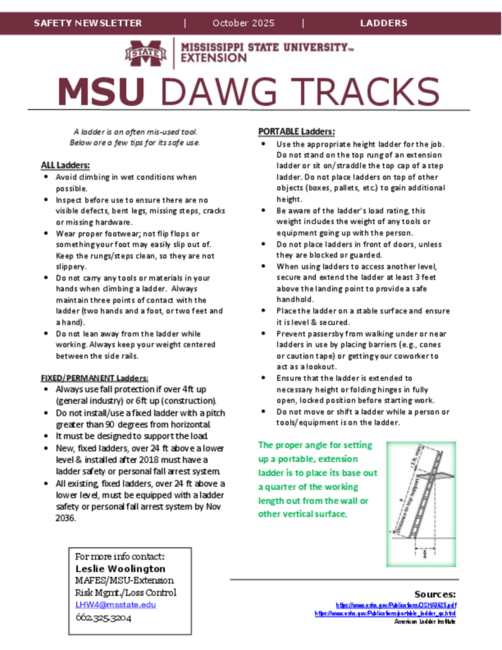Dawg Tracks Safety Talk
Ladders
A ladder is an often mis-used tool.
Below are a few tips for its safe use.
ALL Ladders:
- Avoid climbing in wet conditions when possible.
- Inspect before use to ensure there are no visible defects, bent legs, missing steps, cracks or missing hardware.
- Wear proper footwear; not flip flops or something your foot may easily slip out of. Keep the rungs/steps clean, so they are not slippery.
- Do not carry any tools or materials in your hands when climbing a ladder. Always maintain three points of contact with the ladder (two hands and a foot, or two feet and a hand).
- Do not lean away from the ladder while working. Always keep your weight centered between the side rails.
FIXED/PERMANENT Ladders:
- Always use fall protection if over 4ft up (general industry) or 6ft up (construction).
- Do not install/use a fixed ladder with a pitch greater than 90 degrees from horizontal.
- It must be designed to support the load.
- New, fixed ladders, over 24 ft above a lower level & installed after 2018 must have a ladder safety or personal fall arrest system.
- All existing, fixed ladders, over 24 ft above a lower level, must be equipped with a ladder safety or personal fall arrest system by Nov 2036.
PORTABLE Ladders:
- Use the appropriate height ladder for the job. Do not stand on the top rung of an extension ladder or sit on/straddle the top cap of a step ladder. Do not place ladders on top of other objects (boxes, pallets, etc.) to gain additional height.
- Be aware of the ladder’s load rating, this weight includes the weight of any tools or equipment going up with the person.
- Do not place ladders in front of doors, unless they are blocked or guarded.
- When using ladders to access another level, secure and extend the ladder at least 3 feet above the landing point to provide a safe handhold.
- Place the ladder on a stable surface and ensure it is level & secured.
- Prevent passersby from walking under or near ladders in use by placing barriers (e.g., cones or caution tape) or getting your coworker to act as a lookout.
- Ensure that the ladder is extended to necessary height or folding hinges in fully open, locked position before starting work.
- Do not move or shift a ladder while a person or tools/equipment is on the ladder.
View PDF to see the entire newsletter.
